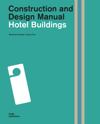Press information
 | Manfred Ronstedt / Tobias Frey Hotel Buildings Construction and Design Manual 225 × 280 mm, 328 pages, more than 260 illustrations, hardcover 978-3-86922-331-5 (English) 978-3-86922-330-8 (German) 978-3-86922-332-2 (Russian) EUR 98.00 / CHF 124.00 September 2014. DOM publishers, Berlin |
New in the series Construction and Design Manuals by DOM publishers:
Manfred Ronstedt / Tobias Frey
Hotel Buildings
What do a hip luxury hotel – a place of carefully staged authentic experience – and a mid-priced business-oriented hotel have in common? Both are expected to operate on a smoothly running organizational structure, with no snags or hitches in the services they provide. What this means on the ground and which practical issues need to be addressed when planning a hotel building is discussed in the new volume in the Construction and Design Manual series.
Hotel Buildings is the first architecture handbook to provide well-founded information on hotel planning. A valuable companion for architects and interior designers engaged in planning or furnishing a hotel, it is equally helpful for project managers and project developers, property developers and hotel operators. This is reflected in the structure of the book, which focuses on comfort, cost effectiveness, and profitability. After all, functionality and user friendliness are relevant for simple hotels, too – perhaps even particularly so.
These core issues also inform the analyses put forward by Manfred Ronstedt and Tobias Frey as they present exemplary buildings ranging from luxury to budget. A substantial part of the book is devoted to the different components of a hotel, from guest rooms and service rooms to the grounds outside the building. The authors consider every single detail, from wall sockets to staircase illumination and noise regulation, and point out apparent trivialities, such as the annoying gap in the curtains which, although impermeable to light, are simply not wide enough to completely cover the windows. Readers thus gain many valuable insights on avoidable but typical planning mistakes.
Beginning with hints on how to develop the initial concept, step-by-step instructions guide readers through all planning stages involved in hotel design. Information on contracts and cost optimization as well as checklists and action charts make this book a practical vademecum for careful and successful planning. An appendix including a glossary, index, and a trilingual technical glossary (en/de/ru) on hotel building rounds off the book.
The Construction and Design Manuals series by Dom publishers lists architecture handbooks that combine solid research with high aesthetic standards. These useful companions provide inspiration and valuable information for architects and their clients alike. Teachers and students of architecture will find them an easy-to-use learning tool. Internationally available. For further information please go to: www.dom-publishers.com



